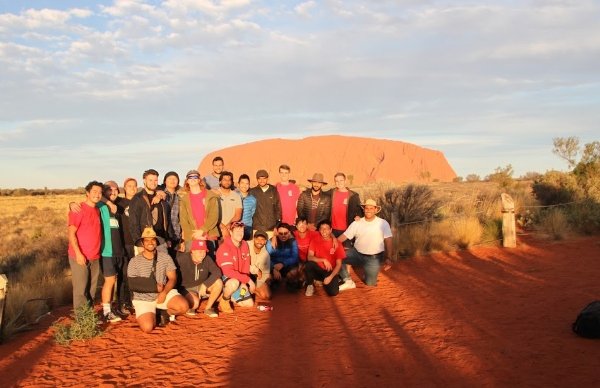Red dirt, deadly animals and desolate landscapes are what foreigners typically think of when they perhaps never experience this Australia. That's why it was a surreal experience to travel to the heartland of the country with other residents from Warrane College at UNSW, a residential college for young men located in Sydney's east.
The workcamp was situated in Haasts Bluff, or Ikuntji, a remote indigenous community 230 kilometres west of Alice Springs. That is about as close as you can get to the middle of Australia, and also as far away from any connectivity. While the Haasts Bluff Community is united by faith and family, only a small portion have meaningful employment, which creates lingering problems like financial instability. However, the indigenous have a strong, almost sacred, connection to their land, and many stories to share about their ancestry and traditions.

The plight of the local people and the beauty of the countryside has long inspired Australia’s celebrated landscape photographer, Ken Duncan, who began a foundation and spent many years helping the Haasts Bluff community. He has a vision to use tourism as a platform for them to make a living and tell their stories, as well as to break down prejudices and ignorance among other Australians.
But it was the shared vision of the local elders and even children, that one day there would be a large cross on Memory Mountain, an iconic landmark nearby, which would stand as a sign of the faith of the people, who were converted to Christianity almost exactly 100 years ago.
Our workcamp focused on this initiative. For several days, we dug eight kilometres worth of pathways around Memory Mountain, while the 20-metre cross was being constructed by professional engineers. Memory Mountain is designed to be a place of future tourism; but also pilgrimage, recollection and reflection. On one of the first days, we climbed to the mountain-top to see the sunrise. Upon arrival it was a truly spiritual experience, one that felt deeply biblical, as a great visual panorama of God's work was unfurled. The array of bush, commanded by towering mountain ridges, a gentle wind, and a blue sky flashed with strokes of yellow, green, red, orange. A camera could not capture the moment, but we hope that the stories of the locals can.
The work was challenging, like any other workcamp, but this time we really felt the remoteness, as we drove out with four-wheel drives, unpacked our tents and set up a camp at the foot of the mountain. We prepared and cooked food, made a fire, and rose early with the light to work each day. In this environment we celebrated the small and simple things. One day when we had already run out of bread, lunch consisted of a slice of chorizo and a slice of ham, sprinkled with mozzarella cheese, all in the palm of our hands. What a feast!
Getting away from city life and spending time with friends in the silence of the desert certainly led to deeper thoughts and a sense of peace. One volunteer said he could now understand how the first Christians felt: we stood shoulder to shoulder during Mass, which was held in one of the larger tents attached to the camper-van. We sat listening to meditations while swatting away flies, without the comfort of a church or chapel. Although we had a tent we could not keep the Blessed Sacrament, but God was truly present, and our faith was strengthened by kneeling down in the dirt during the consecration.
21 residents from Warrane College may have switched off from technological distractions; but we connected in many other important ways. It was deeply humbling to be accepted into the Haasts Bluff community and work alongside the Indigenous people. Although our work was only a small part of the project, we learned a great deal in a very short time; and were moved by the friendliness and openness of our new friends.
And we felt more connected than ever with this land we call Australia. Our petrol tanks were almost bone dry on arriving back in Alice Springs, and the red dust of the outback clung to our belongings, our hair and our clothes. No matter how much you clean some items, the red colour remains. And we hope that’s not the only thing that sticks with us from those unforgettable days in the heart of Australia.
The Alice Springs work camp was organised through Warrane College, a residence for young men at the University of New South Wales in Sydney.
